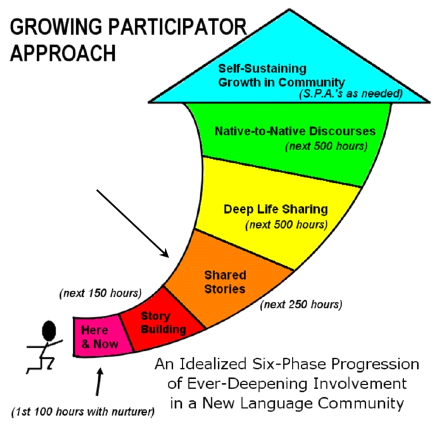So those are the most important philosophical underpinnings of GPA. Now on to the approach itself. GPA is divided into 6 phases, each of which I’ll describe briefly.
Phase 1: the Here and Now Phase. In this phase, you start out not being able to participate at all. So you need a lot of non-verbal contextual clues, like pictures, objects, actions, etc. to help you understand what is going on (to help you improve your participation ability). You’ll be acting out commands from your friend, pointing to the pictures he’s talking about, and trying to make basic descriptions about what someone or something is doing. 100 session hours
Phase 2: the Story Building Phase. In this phase, you’ll start to “loosen your tongue” as you improve your ability to describe tangible objects and actions. You’ll also significantly widen your vocabulary range as you produce and listen to these descriptions. 150 session hours
Phase 3: the Shared Story Phase. Now that you’re more and more able to produce and understand descriptions of tangible, present-tense actions and objects, you’ll move on to focusing on somewhat more abstract stories of past events. You’ll again listen to and tell a lot of stories, using less contextual clues than before. 250 session hours
Phase 4: the Deep Life Sharing Phase. You’re now able to tell and understand a lot of stories, and can start to understand more abstract explanations and cultural nuances as you listen to life stories, cultural explanations, and daily life narrations. You’ll start to go deep in your participation as you learn about the lives and day-to-day experiences of host people on many levels. 500 session hours
Phase 5: the Native-to-Native Phase. In Phase 5, you’ll start to understand native-to-native discourses as you work through them with a friend. You’ll be able to understand more and more of what is happening around you in daily life: the humor, complex stories and ideas, media and other experiences which people participate in. 500 session hours
[pullquote] Phase 2: you’ll start to “loosen your tongue”. [/pullquote]
Phase 6: the Life-Long Phase. This is the never-ending phase which you continue in throughout your sojourn. As you encounter parts of life you’re not able to participate in well, you can do sessions with a friend to work on those domains and to continue to grow in your participation. In addition, most of daily life is now a learning opportunity, or is in your growth zone, so you don’t need to do sessions as much.
So that’s a basic run-down of the Growing Participator Approach. To finish, I’ll explain a few of the many methods used in the approach.
1. The “dirty dozen” method. This activity is used in Phase 1 of the approach. Here, you are introduced to a new set of vocabulary items (usually around 12, centered around a theme). Your friend uses pictures or objects to introduce you to the words: he may use 12 toy animals, or 12 pictures of places around town, or point to 12 things in the room. He starts with two words, pointing to each object/picture and saying what they are in the host language. Then he starts to ask you where each one is, again, in his language. Once you’ve repeated that a few times and you’re starting to get it, he’ll add one more and then another, until you’re recognizing all 12 words as he names them. You don’t need to say a word during the activity: just listen and point/respond. The goal is not mastery, or even an ability to say the words, but simply a basic level of comprehension that can recognize a word when it’s heard in a clear context. This method is great for building up quick and basic recognition of a large number of words.
2. Picture book descriptions: In phase 2, you may be able to make basic descriptions of objects and actions, but you’re still pretty limited in what you can talk about, especially in terms of being precise, natural, clear and accurate in your speech. So you need lots of practice speaking and getting immediate feedback on what you’re staying. That’s why you spend a lot of time describing wordless picture books. For each page of the book, take as much as 30 minutes to describe what is going on, what you find in the picture, what each character might be thinking or planning, the details of a given object, etc. Talk about as much as you can, in as much detail as you can. As you’re going, you’ll say a lot of things in strange or inaccurate ways, and your friend will rephrase them for you. You’ll also just get stuck and not know how to describe something. So your friend will feed you new vocabulary as you try and describe the picture. Then, once you’re done, he’ll go back and describe the picture himself, and you can record his description and a recording in which he says all the new vocabulary words and phrases that came up in the description.
3. Phase 4 life stories: Once you’re ready to start understanding more complex stories and ideas, you can use life story activities. To start out, record your friend telling you his life story. It may be one minute or one hour. Either way, go through that recording and ask (in the host language) about everything you didn’t understand in detail. Then ask your friend to record all the new vocabulary with explanations for each. Once you’ve done that, think through a number of other questions you can ask to find out more about his life and about host life in general: Tell me about your time in university. Did you go on vacation as a family? What was it like finding your first job? As you ask more questions, you get more and more new vocabulary and more and more material for further questions and deeper understanding of host life.
4. Native-to-native discourses. Understanding native speakers talk to each other is much harder than understanding them talk to you. So you’ll want to grow in your ability to follow native-to-native discourses, whether between 2 people or 20. One great way to do that is to watch TV shows in the host language (if such exist). You can watch them with your friend, stopping them every time you don’t understand any piece of what was said (in other words, every 10 seconds!). Ask for explanation and clarification, and keep a note of new vocabulary. Go through the whole show in detail like that, and then do a vocabulary recording at the end.
That’s a basic summary of the Growing Participator Approach, a language learning approach which I’ve found to be carefully developed, insightful, highly effective, and well-suited for the task of learning to participate in a new world, one step at a time.
by Chris

